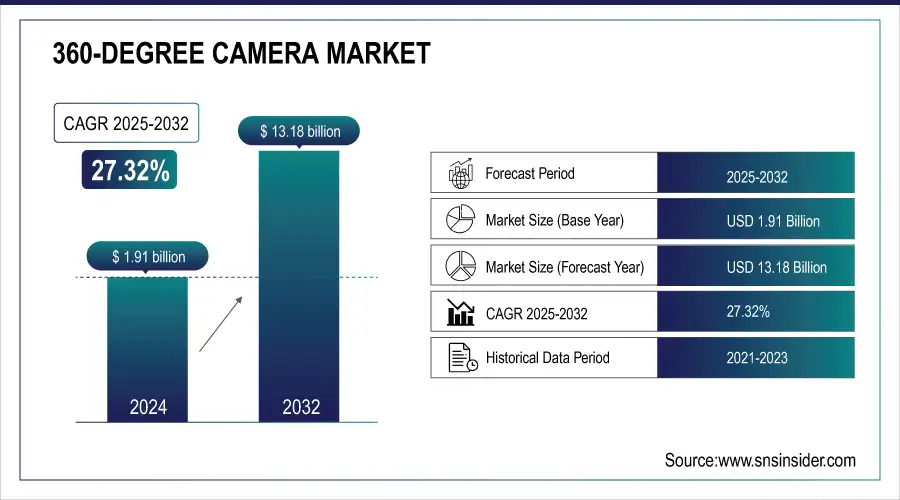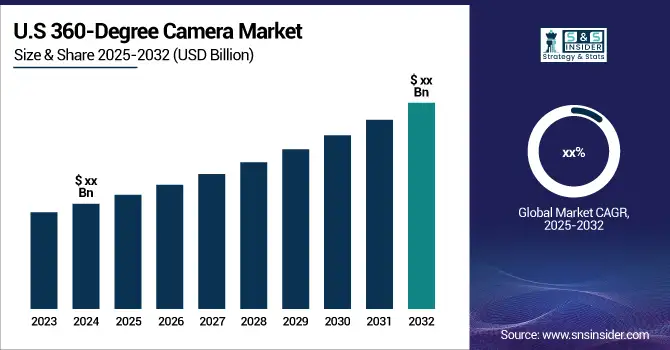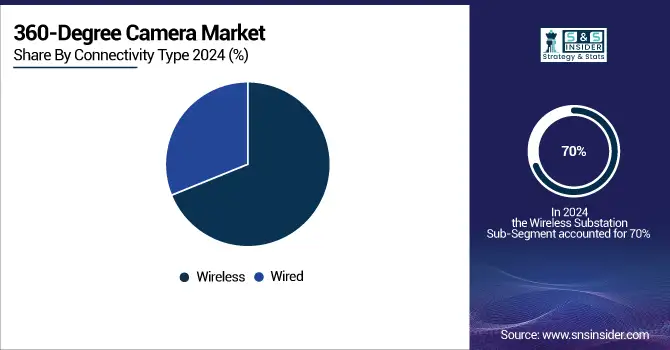360 Degree Camera Market Size Analysis:
The 360-degree Camera Market size was valued at USD 1.91 billion in 2024 and is expected to reach USD 13.18 billion by 2032 and grow at a CAGR of 27.32% over the forecast period 2025-2032.
The 360-degree camera market is rapidly expanding, driven by demand for immersive content in real estate, tourism, education, and entertainment. Advancements in AI and LiDAR enable high-resolution experiences that boost engagement, marketing effectiveness, and learning outcomes, making 360-degree cameras vital for visual storytelling and audience connection.
360 degree Camera Market Size & Forecast:
-
Market Size in 2024: USD 1.91 Billion
-
Market Size by 2032: USD 13.18 Billion
-
CAGR: 27.32% (2025–2032)
-
Base Year: 2024
-
Forecast Period: 2025–2032
-
Historical Data: 2021–2023

Get more information on 360-Degree Camera Market - Request Sample Report
360-Degree Camera Market Key Insights & Trends
-
Rising demand for immersive content in real estate, tourism, education, and entertainment is fueling market growth, with virtual tours increasing property sales by up to 30%.
-
Integration of AI and LiDAR technologies enhances image stabilization, object tracking, and resolution, improving user experience and expanding professional use cases.
-
The entertainment and gaming industries are key adopters, leveraging 360° content for virtual reality (VR) storytelling and interactive gameplay to boost audience engagement.
-
Visual marketing impact remains strong — 65% of people are visual learners, and visual content drives 94% more views, making 360° videos essential for digital campaigns.
-
The education and corporate training sectors are increasingly using 360° video simulations to improve learning outcomes and engagement.
-
Asia-Pacific is emerging as the fastest-growing region, driven by smartphone penetration, affordable VR devices, and rising interest in virtual tourism and social media integration.

360-Degree Camera Market Drivers
-
The growing demand for 360-degree cameras in construction, marketing, and immersive technologies is driving market expansion
The 360-degree camera market is witnessing significant growth due to its transformative impact on project management, marketing, and immersive technology solutions. In the construction sector, 72% of professionals use these cameras for project oversight, with 54% leveraging them for building design and 51% for construction monitoring. Despite their utility, challenges like low image quality (30%), cumbersome sharing processes (28%), and limited capture range (26%) have spurred advancements in imaging technology. These improvements address industry needs for enhanced visualization and seamless integration into workflows. A clear distinction between CGI-based virtual reality and 360 videos has also fueled adoption, with the latter offering a comprehensive spatial perspective crucial for immersive technology projects. By enabling effective planning for VR/AR integrations, 360-degree cameras are becoming indispensable across industries.
For architecture, engineering, and construction (AEC) professionals, nearly 50% rely on these cameras for documentation, boosting collaboration and minimizing errors. Platforms like CloudPano empower businesses to create self-guided virtual tours, enhancing customer engagement and operational transparency. These innovations extend the application scope of 360-degree cameras into areas like immersive storytelling and real estate, driving higher engagement and improving decision-making. The continuous refinement of features, such as extended capture ranges and seamless sharing capabilities, further solidifies their role in modern workflows. By addressing technological limitations and bridging gaps in visualization, 360-degree cameras are revolutionizing multiple sectors, from construction to marketing, ensuring a robust market trajectory and fostering innovation.
360-Degree Camera Market Restraints
-
Challenges in integrating 360-degree cameras include synchronization issues, camera calibration, platform compatibility, and the need for high data transfer.
Integrating 360-degree cameras into systems presents significant challenges, particularly in areas like hardware and software synchronization, which are critical for accurate data capture. While software synchronization works well in static settings, real-time applications, such as those in construction or robotics, require more complex hardware synchronization. Additionally, selecting the correct camera interface (e.g., MIPI vs. USB) and ensuring compatibility with platforms like NVIDIA Jetson is essential for achieving optimal performance. Another hurdle is camera calibration, which is necessary to minimize distortion and ensure seamless image stitching. Furthermore, camera placement and supporting infrastructure that can handle high data transfer rates are also significant challenges. These issues have particular relevance in industries like construction, where 360-degree cameras enhance project management, documentation, and remote monitoring, as well as facilitate real-time reporting and site inspections. Incorporating these cameras into a workflow offers notable benefits, including increased efficiency, time savings, and cost reduction.
However, addressing the technical aspects of integration, such as selecting appropriate interfaces and calibrating cameras to prevent image distortion, is essential for smooth implementation. These advancements are helping professionals in the construction sector improve project management, streamline operations, and ensure accurate documentation of all stages of construction projects. As the use of 360-degree cameras becomes more prevalent in industries like construction, the need for seamless integration with existing systems becomes increasingly critical for maximizing their potential.
360-Degree Camera Market Segment Analysis
By Connectivity Type
The wireless segment dominates the 360-degree camera market, accounting for approximately 70% of the market share in 2024. This dominance is driven by the increasing preference for wireless connectivity, which provides greater flexibility and convenience in camera setup and operation. Wireless cameras offer the advantage of remote access, eliminating the need for physical connections and enabling easy integration with cloud-based systems. Additionally, the growing adoption of wireless technology in various industries, such as real estate, tourism, and event management, has further propelled the demand for wireless 360-degree cameras, as they facilitate real-time streaming, seamless communication, and enhanced user experience.
The wired segment in the 360-degree camera market is projected to be the fastest-growing segment from 2025 to 2032. This growth is attributed to the advantages of wired cameras in offering high quality, uninterrupted video streams, especially in professional settings that demand consistent performance. Wired cameras ensure stable connections with minimal risk of interference, making them ideal for real-time applications like live events, security, and surveillance. Additionally, the increasing demand for high-definition content and the need for reliable connectivity are key drivers of the wired segment's growth.

By Resolution
In 2024, the HD resolution segment dominates the 360-degree camera market, holding around 69% of the share. Regionally, North America leads the market due to technological advancements and a strong presence of key industry players. The demand for high-definition cameras is particularly strong in sectors such as real estate, media, and entertainment in the U.S. Meanwhile, the Asia Pacific region is witnessing rapid growth, driven by sectors like gaming and tourism. Europe is also seeing increased adoption as industries prioritize high-quality content creation. This regional growth is fueled by the rising demand for enhanced visual experiences.
The UHD (Ultra High Definition) segment is expected to be the fastest-growing segment in the 360-degree camera market from 2025 to 2032. This growth is driven by the increasing demand for superior image quality in industries such as entertainment, gaming, real estate, and virtual tours. UHD resolution offers more detailed and immersive experiences, which is especially appealing for applications requiring high-quality content. As technological advancements make UHD more accessible and affordable, its adoption is set to rise across various sectors, enhancing visual experiences and driving market expansion. This trend indicates a shift towards higher quality, professional-grade 360-degree cameras.
360-Degree Camera Market Regional Analysis
Asia-Pacific 360-Degree Camera Market Insights
Asia-Pacific leads the global market with a 38% share, fueled by expanding smartphone penetration, affordable 360° camera options, and booming digital ecosystems in China, India, Japan, and South Korea. The region’s growing tourism and e-learning industries, coupled with strong social media engagement, make it the fastest-growing market globally.

Need any customization research on 360-Degree Camera Market - Enquiry Now
North America 360-Degree Camera Market Insights
North America holds around 28% of the global 360-degree camera market, driven by high adoption across real estate, film, entertainment, and enterprise training sectors. Strong infrastructure, widespread use of VR/AR devices, and advanced marketing strategies support steady growth. The U.S. remains the dominant contributor with significant technological integration and content innovation.
Europe 360-Degree Camera Market Insights
Europe accounts for about 20% of the market, with increasing adoption in real estate, museums, tourism, and creative production. The region’s focus on data security and content quality drives demand for professional-grade cameras. Countries like Germany, the U.K., and France lead the regional growth through innovative use of immersive marketing and virtual exhibitions.
Latin America 360-Degree Camera Market Insights
Latin America captures approximately 7% of the global 360-degree camera market. Demand is growing in Brazil, Mexico, and Argentina, primarily in tourism, entertainment, and real estate marketing. Despite infrastructure and pricing challenges, local content creators and small businesses are embracing cost-effective 360° tools for visual storytelling.
Middle East & Africa 360-Degree Camera Market Insights
The Middle East & Africa hold a 7% market share, driven by high-end real estate, tourism projects, and smart city initiatives. Gulf nations like the UAE and Saudi Arabia are leading adoption, using 360° visuals to promote luxury developments and events. Ongoing digital transformation and government-led tourism programs continue to boost regional demand.
360-Degree Camera Companies are:
-
360fly (360fly 4K Camera)
-
Denso Corporation (360-degree cameras for automotive use)
-
Digital Domain Productions (Digital Domain 360 VR Cameras)
-
Freedom360 LLC (Freedom360 Camera)
-
GoPro (GoPro Max)
-
Insta360 (Insta360 One X2, Insta360 One R)
-
LG Electronics (LG 360 CAM)
-
Nikon (Nikon KeyMission 360)
-
PONONO (Professional 360 GmbH) (PONONO 360 Camera)
-
Ricoh (Ricoh Theta Z1)
-
Samsung Electronics (Samsung Gear 360)
-
Vuze Camera (Vuze XR)
-
Xiaomi (Xiaomi Mi Sphere 360 Camera)
-
YI Technology (YI 360 VR Camera)
-
Immervision (Immervision 360 Camera Solutions)
List of Suppliers who provide raw material and component for the 360-degree camera market:
-
Sony Corporation
-
LG Electronics
-
Panasonic Corporation
-
Samsung Electronics
-
Nikon Corporation
-
Canon
-
Sharp Corporation
-
Omnivision Technologies
-
STMicroelectronics
-
Qualcomm
360-Degree Camera Market Competitive Landscape:
Nikon Corporation is a leading player in the 360-degree camera market, leveraging its strong expertise in imaging and optical technologies. Known for innovation in digital cameras and lenses, Nikon offers high-performance 360° solutions that cater to professional photography, filmmaking, and virtual reality applications. The company focuses on integrating advanced features such as 4K video capture, image stabilization, and seamless connectivity to enhance immersive content creation. Through continuous R&D investments and strategic collaborations, Nikon aims to expand its presence in the growing VR and 360° imaging segments, addressing rising demand across real estate, entertainment, and education industries.
-
October 15, 2024: The Nikon Nikkor Z 600mm F6.3 VR S is a lightweight, weather-sealed telephoto lens weighing 3.2 lbs. Its Phase Fresnel optics offer excellent image quality while minimizing weight. Although it lacks Arca-Swiss compatibility and 90-degree detent stops, it remains a top choice for wildlife photographers needing portability and performance.
Xiaomi Corporation is a prominent participant in the 360-degree camera market, known for delivering affordable yet technologically advanced imaging solutions. Leveraging its strong ecosystem of smart devices and IoT integration, Xiaomi’s 360° cameras cater to consumers seeking immersive video and photography experiences. The company emphasizes compact design, AI-driven image processing, and seamless connectivity with smartphones for real-time sharing. Its products, such as Mi Sphere and home security 360° cameras, have gained popularity in both consumer and commercial segments. Xiaomi continues to innovate by integrating AI, cloud storage, and 4K capabilities, strengthening its position in the global 360-degree camera landscape.
-
July 19, 2024: The Xiaomi 360 Home Security Camera 2K features a 360° panoramic view and AI-powered human motion detection, It includes simple setup steps, a solid build, and a convenient design with a micro-USB port and microSD card slot for added functionality
| Report Attributes | Details |
| Market Size in 2024 | USD 1.91 Billion |
| Market Size by 2032 | USD 13.18 Billion |
| CAGR | CAGR of 27.32% From 2025 to 2032 |
| Base Year | 2024 |
| Forecast Period | 2025-2032 |
| Historical Data | 2021-2023 |
| Report Scope & Coverage | Market Size, Segments Analysis, Competitive Landscape, Regional Analysis, DROC & SWOT Analysis, Forecast Outlook |
| Key Segments | • By Connectivity Type (Wired, Wireless) • By Resolution (HD, UHD) • By Verticals (Automotive, Commercials, Military, Healthcare, Others) |
| Regional Analysis/Coverage | North America (US, Canada, Mexico), Europe (Eastern Europe [Poland, Romania, Hungary, Turkey, Rest of Eastern Europe] Western Europe] Germany, France, UK, Italy, Spain, Netherlands, Switzerland, Austria, Rest of Western Europe]), Asia Pacific (China, India, Japan, South Korea, Vietnam, Singapore, Australia, Rest of Asia Pacific), Middle East & Africa (Middle East [UAE, Egypt, Saudi Arabia, Qatar, Rest of Middle East], Africa [Nigeria, South Africa, Rest of Africa], Latin America (Brazil, Argentina, Colombia, Rest of Latin America) |
| Company Profiles | 360fly, Denso Corporation, Digital Domain Productions, Freedom360 LLC, GoPro, Insta360, LG Electronics, Nikon, PONONO, Ricoh, Samsung Electronics, Vuze Camera, Xiaomi, YI Technology, and Immervision are key players in the 360-degree camera market. |

